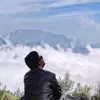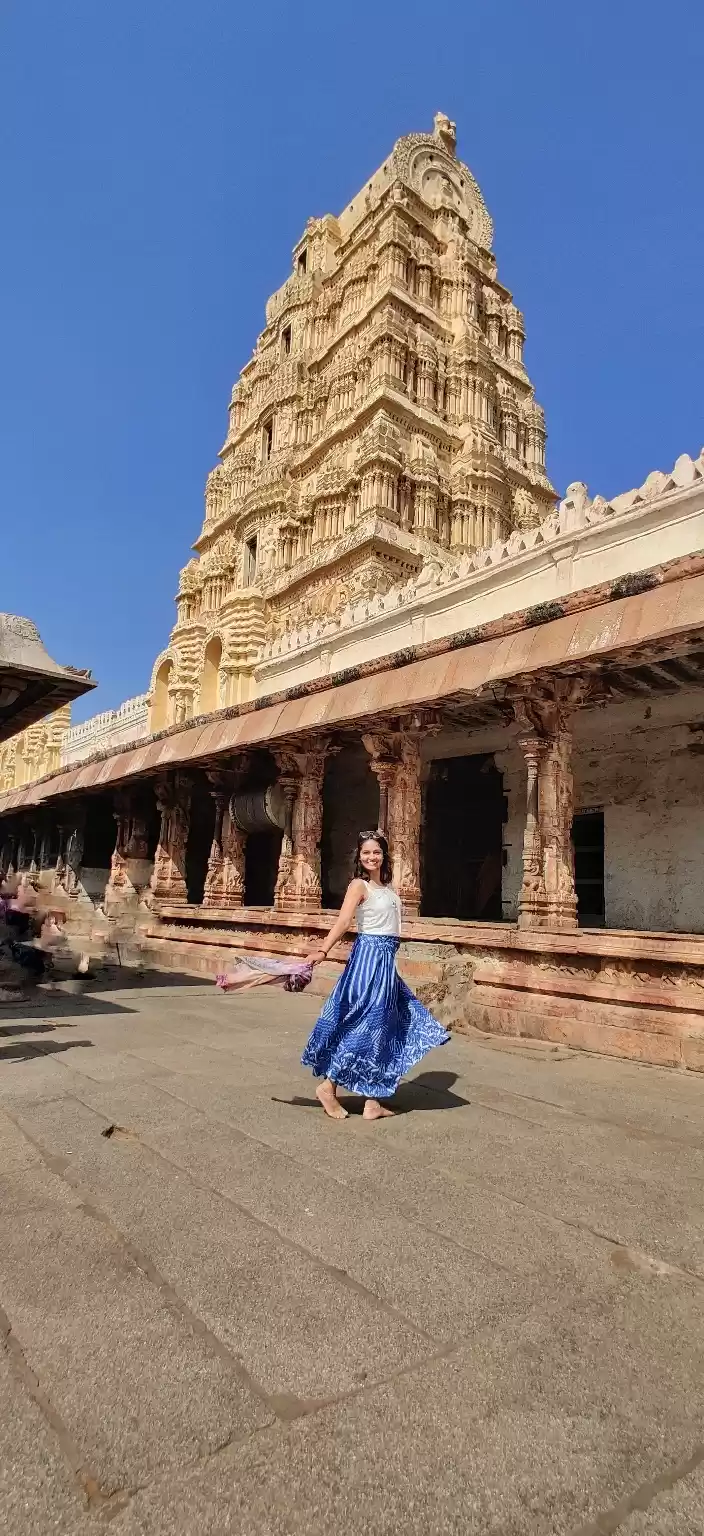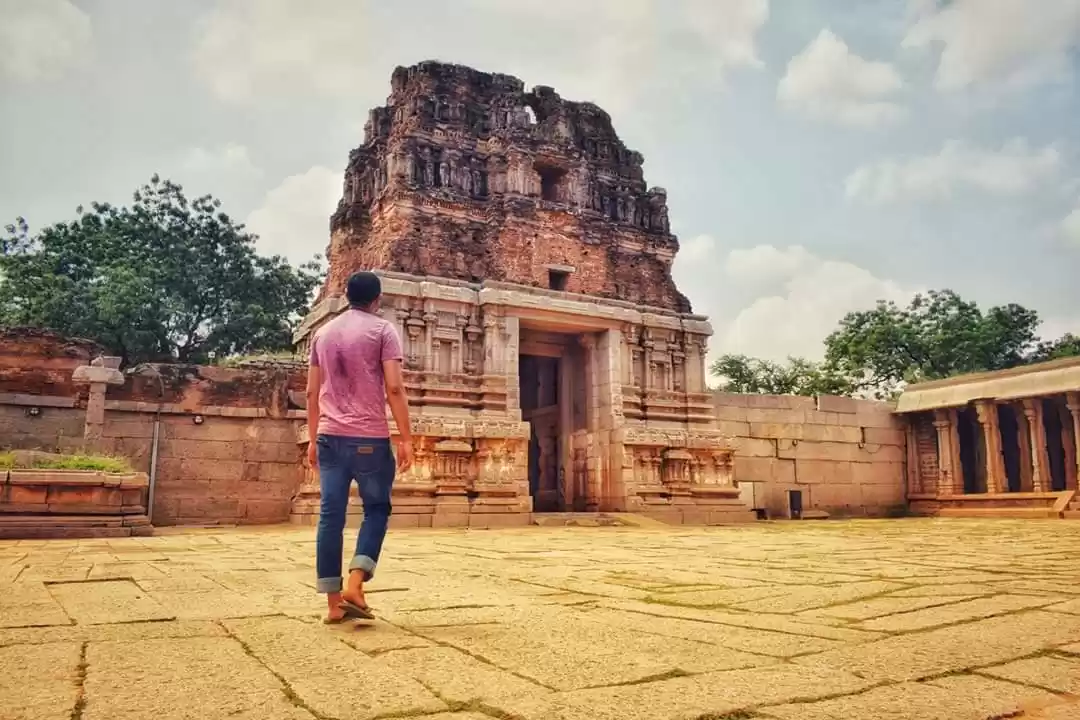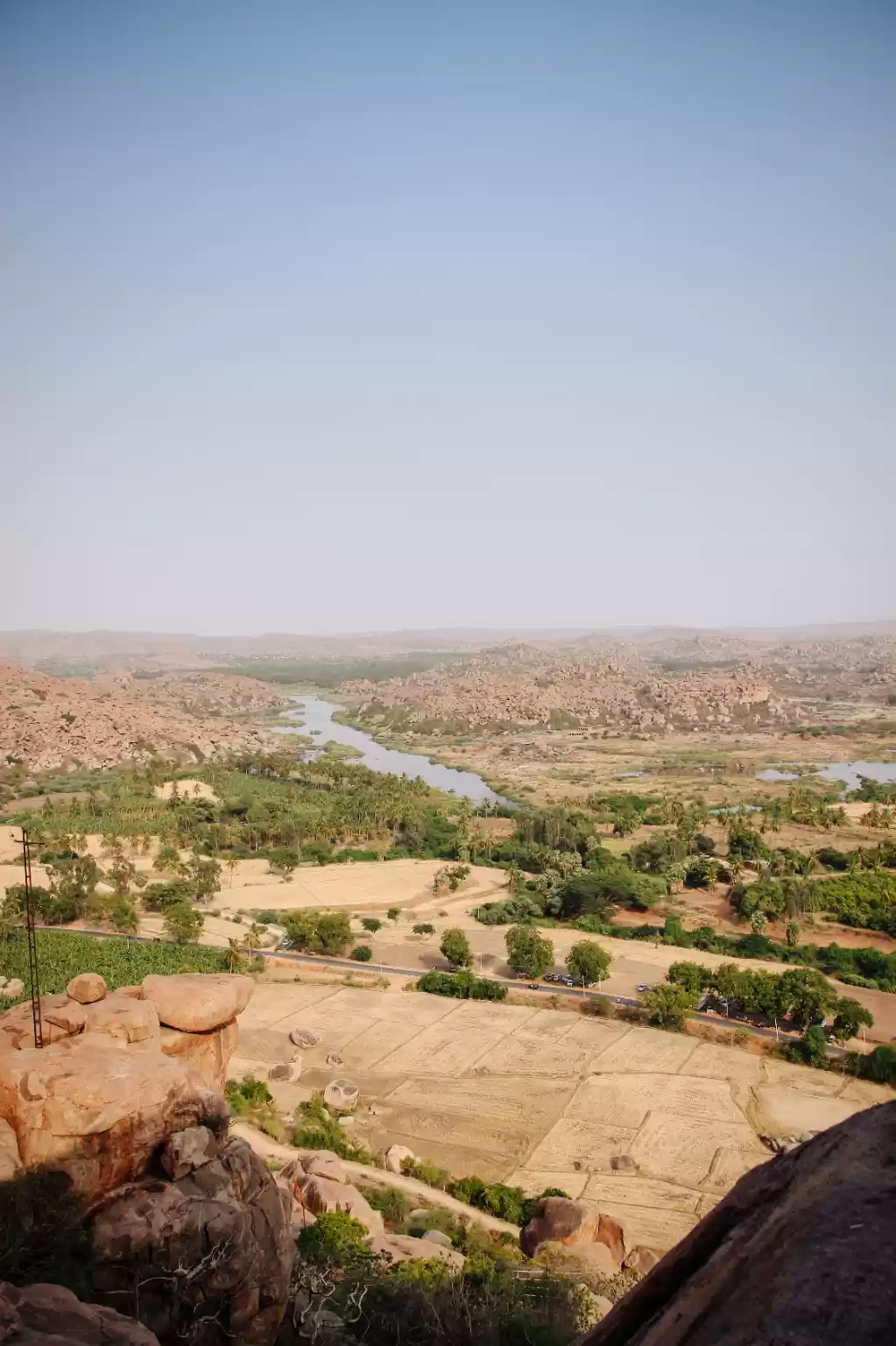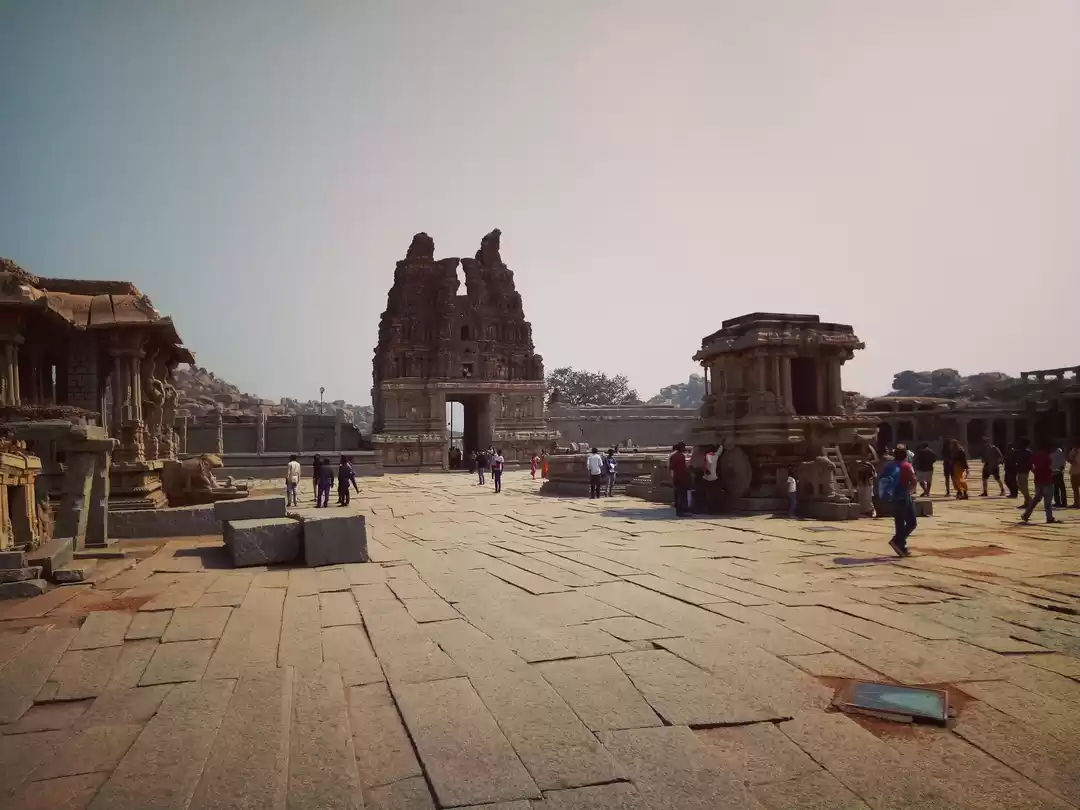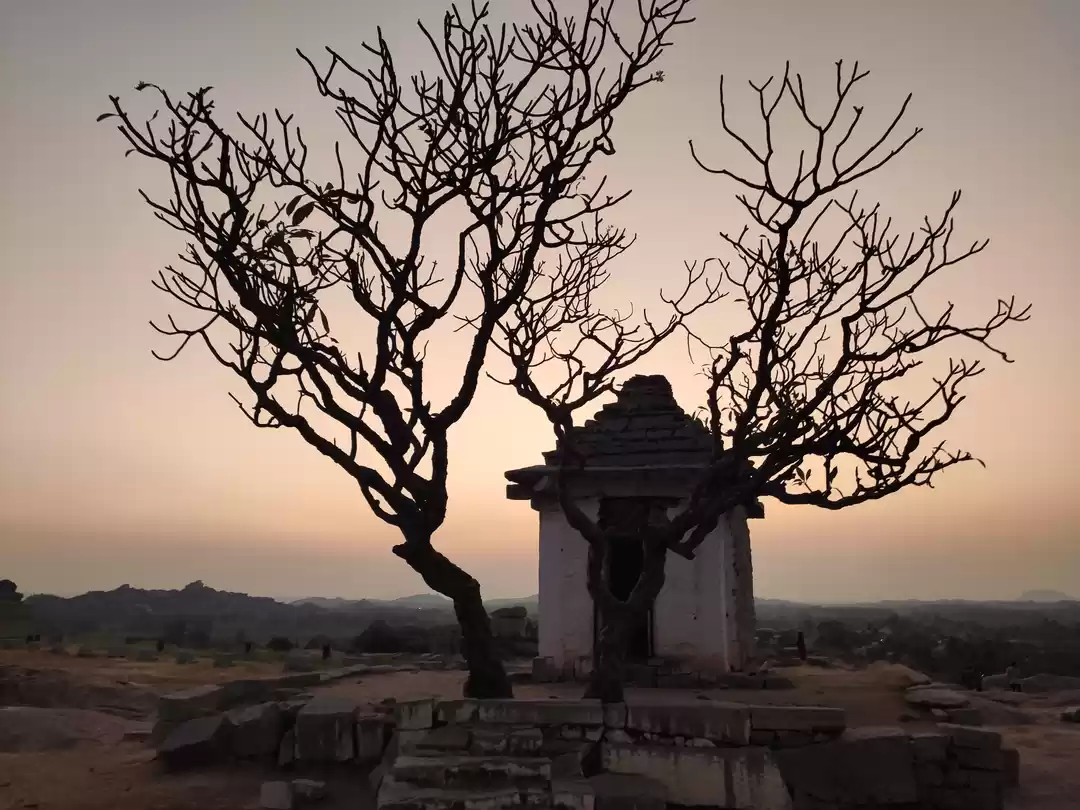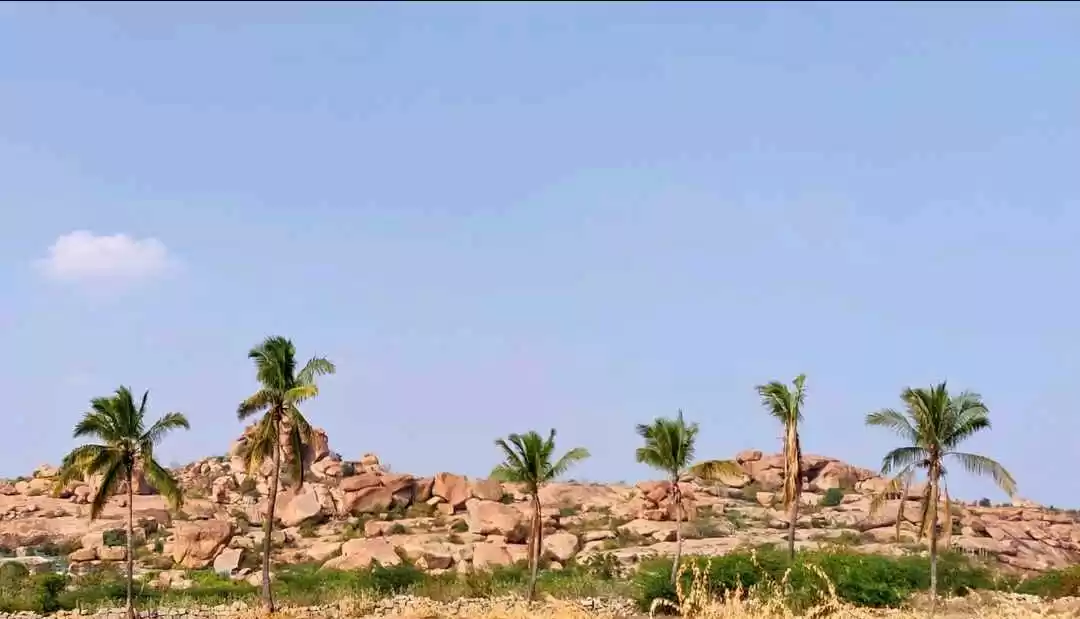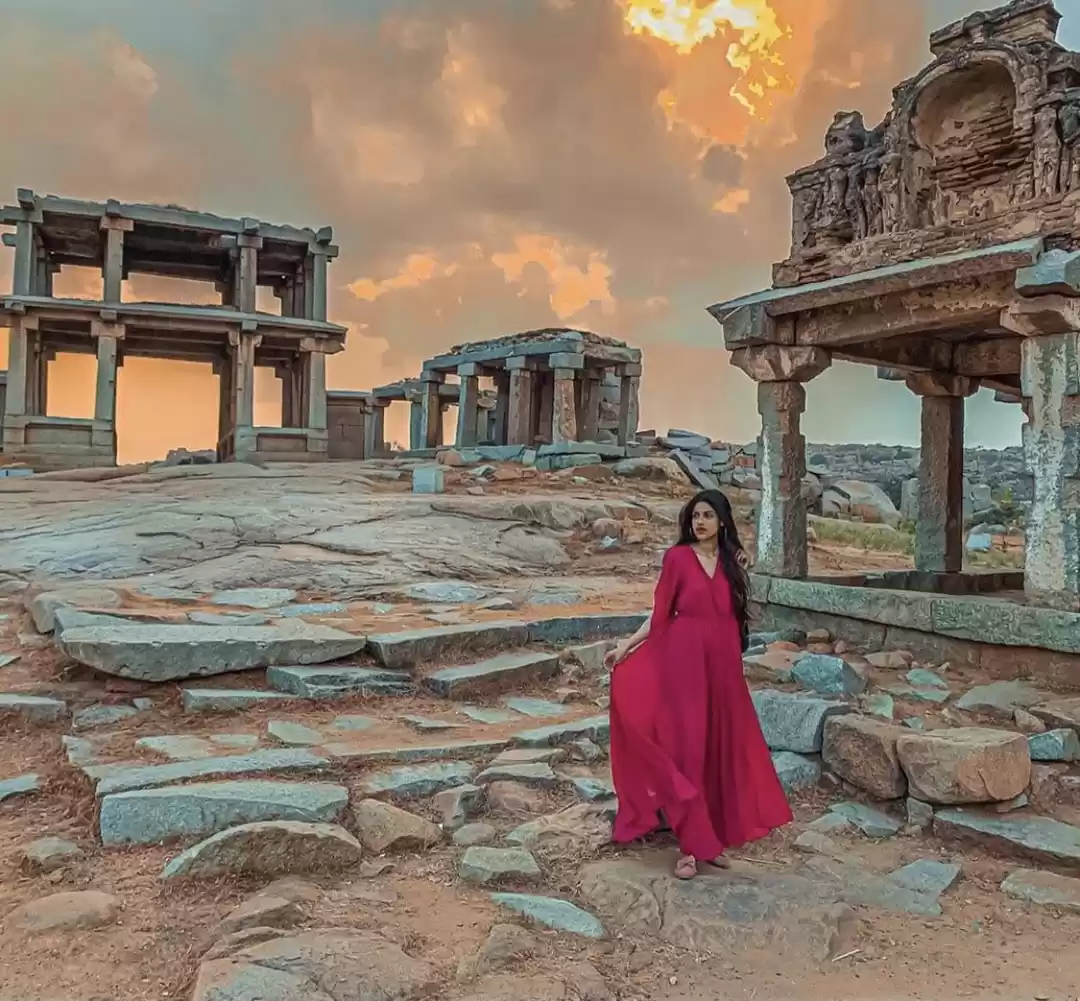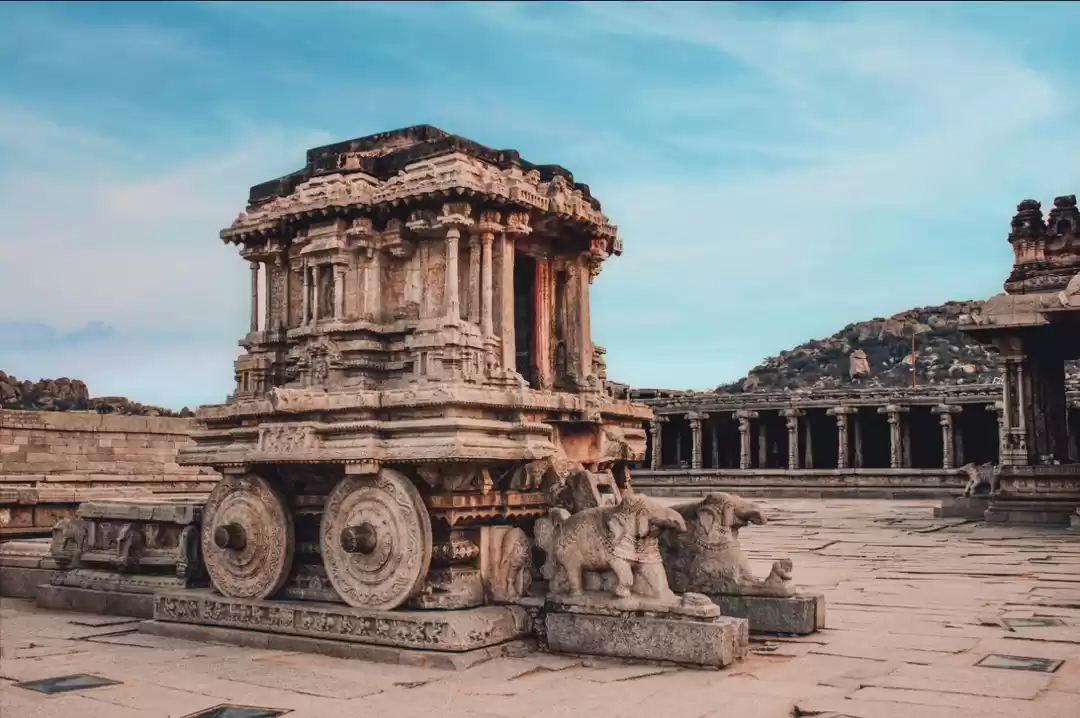
We commenced our journey from Bangalore availing the AC sleeper bus, they run on a regular basis from Bangalore to Hospet, the nearest town to Hampi. The buses are mostly scheduled for an overnight journey and our bus took off from Bangalore around 9 pm, reaching Hampi the subsequent morning around 8’30, though the scheduled time was a tad early. From Hospet, one can take the auto-rickshaws or cabs to reach Hampi. The half an hour journey covering a stretch of 12 odd km enthralls you with rural landscapes and as we entered the vicinity of Hampi demarcated by an entrance we experienced a sudden rush. The best plausible reason being the sudden change in landscapes and terrain, landscapes reflecting a primeval picturesque of ruins and boulder formation. The sight of a multitude of balancing rocks lying in a vegetative state with the bright sun showering its dazzling rays creates a beautiful backdrop.
Our maiden visit to Hampi was simplified as we went through a lot of travel journals browsing the web. We came across an array of options for accommodation, eating and places to visit in and around. The river, Tungabhadra flowing by the Virupaksha temple draws a divide between two regions of Hampi. The stretch adjoining the Virupaksha temple has the temples dedicated to a number of Hindu deities constructed during the late medieval periods. Holding onto the notion of exploring one area at a time we took leaps over the surfaced boulders lying on the river bed to reach the other side of the river, to what they colloquially call as the “Hippie Island" known to the locals as Virupapura Gadde. Since we had been during the peak of summers the river had almost dried up, or else one needs to take a boat during the season to reach the other side of the river. One can predominantly witness a lot of coracles a.k.a Dongi in native tongue on either side of the banks during the season for traversing on either side of the river, they merely charge INR 10 from each person to cross the river.
Our basic research and travel diaries of other people heaped a lot of praise on Shanti Guest House in Virupapura Gadde, further, the images of the property were alluring, which coaxed us to secure an accommodation there. A call prior to the day of traveling assured us availability, which is highly uncertain during peak season as they get booked well in advance. But if you are planning to take a trip to Hampi, a stay here will definitely invoke a sense of sanctity; with lush green paddy fields facing the small cozy cottages lined up in one stretch and the shallow waters of river Tungabhadra offering a picturesque backdrop, it serves as an ideal escape place to revel in the midst of nature and witness different hues of sunlight gleaming over the stretch of boulders and rocks.


We had booked a cottage with all basic amenities and we decided to explore the stretch along Virupapura Gadde on Day 1. To help us draw a better itinerary for the next two days we counseled one of the attendants at the guesthouse, without much ado we rented a couple of gearless bikes. So in this part of the Hampi commute isn’t a problem at all, as you can rent out vehicles at minimal rates. We were billed 200/day for each bike we had rented, exclusive of fuel costs. After having a hearty American breakfast at the Shantis’ we headed out for our escapade. On our way to the Sanavar lake the which was our first destination we came across a person who sought for a lift. Since I was riding solo I thought of helping him out and it turned out that he owns dongris by the Sanavar lake and he gives rides to tourists. From him we learnt that most of the adventure activities like bouldering and cliff jumping take place predominantly during the season that stretches from October to March, we were keen on cliff jumping but due to the low water levels during the summers it was discouraged but he compensated all our excitement by taking us to a beautiful stretch of sanavar lake where the entire lake was surrounded by the boulder formation and the stretch of gravel sand, smeared in the heat of the scorching sun. We were taken to a spot in the middle of the lake in the dongris where it seemed like a private lake to us, with no other souls in the vicinity. It turned out to be a peaceful encounter with the rugged summer terrain of Hampi as we swam across the edges of the lake and soaked in some warmth of the sun. We chilled by the side of the lake for over an hour and as we had asked the Dongriman, he came to pick us up at the scheduled time. Though it was hardly a 10-15 minute ride to the lake shore from where we could take the motorable road but it was a time-saving affair as we would have exhausted close to an hour if we had hiked to the place where we had parked our two-wheelers.
From there we headed towards a café named White Elephant, we could see small billboards and graffiti’s on the rocks of the Vijayanagara while riding towards the Hanuman top another major attraction in this part of Hampi. Exhausted and in quest of a place to relax and please our taste buds we landed up in White Elephant café. It is, cozy café with the picturesque view of the of the petite hills with the same boulder formation all across them, the paddy fields in front of the hills were adding the melange to the color palette along with the coconut trees at every crossroads of the paddy fields. We ordered a few Israeli and continental dishes at the café, though the food won’t elevate your gastronomical experience but it was worth rejuvenating our starving souls and the chilled beer turned out to be an elixir in disguise.
All this while a constant vigil was being kept on time as we didn’t want to miss the sunset from the Hanuman Top aka the Anjaneya Hill. One of the major attractions in this part of Hampi, it is believed to be the birthplace of Hanuman, one of the revered Hindu deities. Though it is highly arguable as Gokarna in Karnataka also claims of the same historical heritage but nevertheless, our purpose was to cherish the view from the hilltop. Thanks to the stairs that have been constructed to accomplish a smooth climb up the hill, we took close to half an hour for our ascend of 487 stairs to the top of the hill. Do ensure to carry water from the stalls at the foothills as you won’t find any source throughout the climb until you reach the top, the afternoon heat of the sun might give you an exhaustion but on completion of the ascend one realizes that it was pretty much worth the effort. Apart from the temple area, one can witness huge boulders balancing at the top of the hill and it offers a panoramic view of the entire stretch of Anegundi, the historical village located at a distance of 5kms from Hampi. The rugged terrain of Anegundi along with the ruins, the stretch of paddy fields along the river Tungabhadra and the small villages and habitations spread across the plains is indeed a sight for the sore eyes. And as the sunset befalls one can witness different hues across the plains as if the Mother Nature embeds an array of filters to a frame over a period to captivate ones’ imagination.

After witnessing the mesmerizing sunset, we headed back to our homestay. On the way, one would find remains of the Aqueduct, the water canal system from Vijayanagara kingdom lying in ruins. It resembles a giant stone bridge in ruins. Once we reached the homestays we relaxed until the latter half of the evening and had a leisure time in the shacks inside the Shantis over a few drinks and narratives from the local staff at the Shantis about Hampi and the culture of the inhabitants there. Exhausted we headed to our beds early, knowing the following day would be hectic as we had to witness the archeological marvels of Hampi.

With an urge to witness the sunrise I woke up early and strolled towards the backyard of Shanti's that faces the paddy fields, further graced by the beautiful stretch of lush greenery and the turquoise blue stream of Tungabhadra. I ordered a cup of tea and witnessed a magnificent sunrise as the sun gradually rose past the small hills and engulfed the entire plains with its lustrous rays. And over the next half an hour we witnessed a herd of sheep, thronging near the paddy fields to graze on the stretch of foliage. The intrigue to have a close in view of the river pushed me to walk past the paddy fields and grazing area towards and river and it turned out to be a soothing experience as the river was gleaming with the early morning sunrays and to complement the picturesque backdrop, the river bank was adorned by lotuses on the river bank. As much as I wished to take a bath in the river but the hands of the clock weren't favorable, so after capturing the landscapes on lenses I strolled back to Shantis and grabbed a quick breakfast.

And hence we took off to our exploration of Ancient Hampi, crossing the river. Since we had a time crunch we decided to take an auto-rickshaw, it quoted a reasonable price to take us on a round of all the major tourist attractions of Hampi. Since Virupaksha temple was right near to the starting point where we would eventually come back later in the evening, we started with Kadale Kalu Ganesha, the exterior of this temple consisting of the elegant pillared mandapa to the front would remind anyone of the Parthenon located in Athens, Greece the classic Greek architecture, especially with the pillars and the backdrop but what really stands out in this temple is the tall 4.5 meters monolithic Ganesha carved out of a huge boulder, a glimpse of an elite craftsmanship from that era. Right opposite to it there lies the ruins to one of the biggest medieval spices, gemstones and jeweler market. Back in the glory days, the Vijayanagara Empire was one of the most extravagant markets in the world trading in gemstones, diamond, and spices. It attracted merchants and traders all across the globe and the travel diaries of many travelers are testaments to the affluence of this empire back in the heydays. Right in the middle of the market there lies the holy stepped tank with a mandapa at the center. This was only used for storage but also during the float festivals aka Teppostsava. The next marvel we witnessed was the Narasimha Shrine, the huge monolithic sculpture of Lakshmi Narasimha is one of the most outstanding works of sculptural art of Vijayanagara. The 6.7-meter sculpture was hewn out of a massive boulder in 1528 A.D during the reign of Krishnadevaraya. Very close to the shrine of Narasimha is an interesting shrine with a huge monolithic Shiva linga of nearly 3 meters high. The lower part of the linga remains in water throughout the year. The source of water is through a small canal drawn from the Tungabhadra river.

The next marvel that we visited was Prasanna Virupaksha, a.k.a the underground Shiva temple, dated back to 14th century A.D the visit inside the temple will surely give you goose bumps as it is pitch dark inside and to my utter surprise when some other tourists flashed light on the ceilings of the underground mandapa, I saw numerous bats hanging upside down which sent chills down my spine and I opted to make a smooth walk past the hallway of the underground mandapa. Amidst the scorching heat, the buttermilk stored in earthen clay pots can be a bliss to your dry throats and one can find the local vendors selling the same at the entrances of the major tourist attractions in Hampi,
(P.S- If you like pickles, do try the spicy mango pickle with buttermilk).
Further, we explored the Indo-Islamic style of architecture reflected in Lotus Mahal and the Elephants Stable, Parshwantha temple, Ranga temple, Hazara Ramachandra temple and Pansupari Bazaar. The entire stretch of temples is in the same enclosure, so it won’t be a hassle to visit all of them.

By the time we wrapped up exploring all the above places we were pretty exhausted and dehydrated, the scorching heat of summer wasn’t showing any mercy to us. We decided to grab our lunch and commence our exploration in the latter half of the day. We asked the auto-rickshaw driver to take us to a restaurant catering to local cuisine and ended up in Hotel Ashok. I am not sure if you can find it on Google as it is a small restaurant and on demand, they even serve beer inside the cabins. As we were starving without much thought we ordered for the chicken and mutton masala along with the rotis and ghee rice. Though I don’t recommend the rotis the gravy based meat items along with rice are a must here. We relished our meals as it was a special gastronomical experience very different from the other south Indian regional cuisines. With a rich blend of spices and thick curry, anyone who cherishes spicy food will love the regional cuisine here.
After a hearty meal, we headed towards Vitthala Temple. This is one of the most important temples found in Hampi as it marks the highest workmanship indicating the mature Vijaynagara phase of architecture. There are many facets and intricacies of Vithhala temple which is difficult to identify by self exploration, so we booked a guide at a reasonable amount of 200 INR, who guided us through every piece of architecture in the temple area starting from the stone chariot, music pillars and different mandapas with self-exploration architectural display. I strongly suggest one to book a guide, especially for Vitthala temple. All the guides have been through the training from the archeological survey of India and have a vast knowledge of the history of Hampi.

After witnessing the magnificent Vitthala temple we paid a quick visit to Queen bath, this Indo-Islamic architectural marvel is a large square structure with a plain exterior and an ornate interior.

By the time we wrapped up these places we had almost approached the evening. It was obvious that we won’t be able to witness all the shrines, and there we figured out that one needs to spare at least 4 days for exploring Hampi and we had only 2 days and 1 night at our disposal. Never mind, we had a reason to visit again this captivating ruins from the glorious past of our country again. From there we headed to a café named Mango Tree Restaurant. With a basic set up and nice usage of wallpapers and psychedelic Shiva posters, this place stood out among the other cafes in the adjoining Virupaksha temple area. We grabbed some beverages and some snack at the café before taking a stroll in Hampi market. We bought a few merchandises from a store named “Keep calm and be Hampi” right on the parallel road to Virupaksha temple. We had to catch a bus late at 10 pm from Hospet which gave us 2-3 hours to relax so we headed back to the shacks in Shantis, from there we witnessed a glorious sunset and by 8’30 we made move to Hospet. It was a pleasing stroll to the other side of the river under the full moon lit radiant Tungabhadra and the glittering stars, a rare sight to witness for the ones from cities. This pretty much marked the end of our memorable trip through the pages of the glorious past of India and we signed off with many reasons to come back to Hampi. Hampi is an unparalleled experience which has the aura of echoing the rich culture, heritage, and grandeur of the Indian kingdoms from the glory days in its own unique way. I look forward to paying my next visit to Hampi very soon for more memoirs to come.
Swayed by the stimulating narratives and enchanting experiences of travelers, second thoughts never surfaced when a chance came our way to witness the archeological marvel from Ancient India. Hampi known to many as a temple town, recognized as a UNESCO World Heritage Site lies in northern Karnataka, India. Thanks to a long weekend that the last minute plan could be drawn to time travel to an era when Indian Kingdoms were blessed with prosperity & thrived high on opulence. We planned our trip over the last weekend of April, which is presumed to be an “Off-Season” in Hampi as it is the time when the summer makes its way, but in spite of anticipating harsh weather conditions the zeal to explore the Old Vijayanagara Kingdom a.k.a Hampi overpowered our reticence.
We commenced our journey from Bangalore availing the AC sleeper bus, they run on a regular basis from Bangalore to Hospet, the nearest town to Hampi. The buses are mostly scheduled for an overnight journey and our bus took off from Bangalore around 9 pm, reaching Hampi the subsequent morning around 8’30, though the scheduled time was a tad early. From Hospet, one can take the auto-rickshaws or cabs to reach Hampi. The half an hour journey covering a stretch of 12 odd km enthralls you with rural landscapes and as we entered the vicinity of Hampi demarcated by an entrance we experienced a sudden rush. The best plausible reason being the sudden change in landscapes and terrain, landscapes reflecting a primeval picturesque of ruins and boulder formation. The sight of a multitude of balancing rocks lying in a vegetative state with the bright sun showering its dazzling rays creates a beautiful backdrop.
Our maiden visit to Hampi was simplified as we went through a lot of travel journals browsing the web. We came across an array of options for accommodation, eating and places to visit in and around. The river, Tungabhadra flowing by the Virupaksha temple draws a divide between two regions of Hampi. The stretch adjoining the Virupaksha temple has the temples dedicated to a number of Hindu deities constructed during the late medieval periods. Holding onto the notion of exploring one area at a time we took leaps over the surfaced boulders lying on the river bed to reach the other side of the river, to what they colloquially call as the “Hippie Island" known to the locals as Virupapura Gadde. Since we had been during the peak of summers the river had almost dried up, or else one needs to take a boat during the season to reach the other side of the river. One can predominantly witness a lot of coracles a.k.a Dongi in native tongue on either side of the banks during the season for traversing on either side of the river, they merely charge INR 10 from each person to cross the river.
Our basic research and travel diaries of other people heaped a lot of praise on Shanti Guest House in Virupapura Gadde, further, the images of the property were alluring, which coaxed us to secure an accommodation there. A call prior to the day of traveling assured us availability, which is highly uncertain during peak season as they get booked well in advance. But if you are planning to take a trip to Hampi, a stay here will definitely invoke a sense of sanctity; with lush green paddy fields facing the small cozy cottages lined up in one stretch and the shallow waters of river Tungabhadra offering a picturesque backdrop, it serves as an ideal escape place to revel in the midst of nature and witness different hues of sunlight gleaming over the stretch of boulders and rocks.


We had booked a cottage with all basic amenities and we decided to explore the stretch along Virupapura Gadde on Day 1. To help us draw a better itinerary for the next two days we counseled one of the attendants at the guesthouse, without much ado we rented a couple of gearless bikes. So in this part of the Hampi commute isn’t a problem at all, as you can rent out vehicles at minimal rates. We were billed 200/day for each bike we had rented, exclusive of fuel costs. After having a hearty American breakfast at the Shantis’ we headed out for our escapade. On our way to the Sanavar lake the which was our first destination we came across a person who sought for a lift. Since I was riding solo I thought of helping him out and it turned out that he owns dongris by the Sanavar lake and he gives rides to tourists. From him we learnt that most of the adventure activities like bouldering and cliff jumping take place predominantly during the season that stretches from October to March, we were keen on cliff jumping but due to the low water levels during the summers it was discouraged but he compensated all our excitement by taking us to a beautiful stretch of sanavar lake where the entire lake was surrounded by the boulder formation and the stretch of gravel sand, smeared in the heat of the scorching sun. We were taken to a spot in the middle of the lake in the dongris where it seemed like a private lake to us, with no other souls in the vicinity. It turned out to be a peaceful encounter with the rugged summer terrain of Hampi as we swam across the edges of the lake and soaked in some warmth of the sun. We chilled by the side of the lake for over an hour and as we had asked the Dongriman, he came to pick us up at the scheduled time. Though it was hardly a 10-15 minute ride to the lake shore from where we could take the motorable road but it was a time-saving affair as we would have exhausted close to an hour if we had hiked to the place where we had parked our two-wheelers.
From there we headed towards a café named White Elephant, we could see small billboards and graffiti’s on the rocks of the Vijayanagara while riding towards the Hanuman top another major attraction in this part of Hampi. Exhausted and in quest of a place to relax and please our taste buds we landed up in White Elephant café. It is, cozy café with the picturesque view of the of the petite hills with the same boulder formation all across them, the paddy fields in front of the hills were adding the melange to the color palette along with the coconut trees at every crossroads of the paddy fields. We ordered a few Israeli and continental dishes at the café, though the food won’t elevate your gastronomical experience but it was worth rejuvenating our starving souls and the chilled beer turned out to be an elixir in disguise.
All this while a constant vigil was being kept on time as we didn’t want to miss the sunset from the Hanuman Top aka the Anjaneya Hill. One of the major attractions in this part of Hampi, it is believed to be the birthplace of Hanuman, one of the revered Hindu deities. Though it is highly arguable as Gokarna in Karnataka also claims of the same historical heritage but nevertheless, our purpose was to cherish the view from the hilltop. Thanks to the stairs that have been constructed to accomplish a smooth climb up the hill, we took close to half an hour for our ascend of 487 stairs to the top of the hill. Do ensure to carry water from the stalls at the foothills as you won’t find any source throughout the climb until you reach the top, the afternoon heat of the sun might give you an exhaustion but on completion of the ascend one realizes that it was pretty much worth the effort. Apart from the temple area, one can witness huge boulders balancing at the top of the hill and it offers a panoramic view of the entire stretch of Anegundi, the historical village located at a distance of 5kms from Hampi. The rugged terrain of Anegundi along with the ruins, the stretch of paddy fields along the river Tungabhadra and the small villages and habitations spread across the plains is indeed a sight for the sore eyes. And as the sunset befalls one can witness different hues across the plains as if the Mother Nature embeds an array of filters to a frame over a period to captivate ones’ imagination.

After witnessing the mesmerizing sunset, we headed back to our homestay. On the way, one would find remains of the Aqueduct, the water canal system from Vijayanagara kingdom lying in ruins. It resembles a giant stone bridge in ruins. Once we reached the homestays we relaxed until the latter half of the evening and had a leisure time in the shacks inside the Shantis over a few drinks and narratives from the local staff at the Shantis about Hampi and the culture of the inhabitants there. Exhausted we headed to our beds early, knowing the following day would be hectic as we had to witness the archeological marvels of Hampi.

With an urge to witness the sunrise I woke up early and strolled towards the backyard of Shanti's that faces the paddy fields, further graced by the beautiful stretch of lush greenery and the turquoise blue stream of Tungabhadra. I ordered a cup of tea and witnessed a magnificent sunrise as the sun gradually rose past the small hills and engulfed the entire plains with its lustrous rays. And over the next half an hour we witnessed a herd of sheep, thronging near the paddy fields to graze on the stretch of foliage. The intrigue to have a close in view of the river pushed me to walk past the paddy fields and grazing area towards and river and it turned out to be a soothing experience as the river was gleaming with the early morning sunrays and to complement the picturesque backdrop, the river bank was adorned by lotuses on the river bank. As much as I wished to take a bath in the river but the hands of the clock weren't favorable, so after capturing the landscapes on lenses I strolled back to Shantis and grabbed a quick breakfast.

And hence we took off to our exploration of Ancient Hampi, crossing the river. Since we had a time crunch we decided to take an auto-rickshaw, it quoted a reasonable price to take us on a round of all the major tourist attractions of Hampi. Since Virupaksha temple was right near to the starting point where we would eventually come back later in the evening, we started with Kadale Kalu Ganesha, the exterior of this temple consisting of the elegant pillared mandapa to the front would remind anyone of the Parthenon located in Athens, Greece the classic Greek architecture, especially with the pillars and the backdrop but what really stands out in this temple is the tall 4.5 meters monolithic Ganesha carved out of a huge boulder, a glimpse of an elite craftsmanship from that era. Right opposite to it there lies the ruins to one of the biggest medieval spices, gemstones and jeweler market. Back in the glory days, the Vijayanagara Empire was one of the most extravagant markets in the world trading in gemstones, diamond, and spices. It attracted merchants and traders all across the globe and the travel diaries of many travelers are testaments to the affluence of this empire back in the heydays. Right in the middle of the market there lies the holy stepped tank with a mandapa at the center. This was only used for storage but also during the float festivals aka Teppostsava. The next marvel we witnessed was the Narasimha Shrine, the huge monolithic sculpture of Lakshmi Narasimha is one of the most outstanding works of sculptural art of Vijayanagara. The 6.7-meter sculpture was hewn out of a massive boulder in 1528 A.D during the reign of Krishnadevaraya. Very close to the shrine of Narasimha is an interesting shrine with a huge monolithic Shiva linga of nearly 3 meters high. The lower part of the linga remains in water throughout the year. The source of water is through a small canal drawn from the Tungabhadra river.

The next marvel that we visited was Prasanna Virupaksha, a.k.a the underground Shiva temple, dated back to 14th century A.D the visit inside the temple will surely give you goose bumps as it is pitch dark inside and to my utter surprise when some other tourists flashed light on the ceilings of the underground mandapa, I saw numerous bats hanging upside down which sent chills down my spine and I opted to make a smooth walk past the hallway of the underground mandapa. Amidst the scorching heat, the buttermilk stored in earthen clay pots can be a bliss to your dry throats and one can find the local vendors selling the same at the entrances of the major tourist attractions in Hampi,
(P.S- If you like pickles, do try the spicy mango pickle with buttermilk).
Further, we explored the Indo-Islamic style of architecture reflected in Lotus Mahal and the Elephants Stable, Parshwantha temple, Ranga temple, Hazara Ramachandra temple and Pansupari Bazaar. The entire stretch of temples is in the same enclosure, so it won’t be a hassle to visit all of them.

By the time we wrapped up exploring all the above places we were pretty exhausted and dehydrated, the scorching heat of summer wasn’t showing any mercy to us. We decided to grab our lunch and commence our exploration in the latter half of the day. We asked the auto-rickshaw driver to take us to a restaurant catering to local cuisine and ended up in Hotel Ashok. I am not sure if you can find it on Google as it is a small restaurant and on demand, they even serve beer inside the cabins. As we were starving without much thought we ordered for the chicken and mutton masala along with the rotis and ghee rice. Though I don’t recommend the rotis the gravy based meat items along with rice are a must here. We relished our meals as it was a special gastronomical experience very different from the other south Indian regional cuisines. With a rich blend of spices and thick curry, anyone who cherishes spicy food will love the regional cuisine here.
After a hearty meal, we headed towards Vitthala Temple. This is one of the most important temples found in Hampi as it marks the highest workmanship indicating the mature Vijaynagara phase of architecture. There are many facets and intricacies of Vithhala temple which is difficult to identify by self exploration, so we booked a guide at a reasonable amount of 200 INR, who guided us through every piece of architecture in the temple area starting from the stone chariot, music pillars and different mandapas with self-exploration architectural display. I strongly suggest one to book a guide, especially for Vitthala temple. All the guides have been through the training from the archeological survey of India and have a vast knowledge of the history of Hampi.

After witnessing the magnificent Vitthala temple we paid a quick visit to Queen bath, this Indo-Islamic architectural marvel is a large square structure with a plain exterior and an ornate interior.

By the time we wrapped up these places we had almost approached the evening. It was obvious that we won’t be able to witness all the shrines, and there we figured out that one needs to spare at least 4 days for exploring Hampi and we had only 2 days and 1 night at our disposal. Never mind, we had a reason to visit again this captivating ruins from the glorious past of our country again. From there we headed to a café named Mango Tree Restaurant. With a basic set up and nice usage of wallpapers and psychedelic Shiva posters, this place stood out among the other cafes in the adjoining Virupaksha temple area. We grabbed some beverages and some snack at the café before taking a stroll in Hampi market. We bought a few merchandises from a store named “Keep calm and be Hampi” right on the parallel road to Virupaksha temple. We had to catch a bus late at 10 pm from Hospet which gave us 2-3 hours to relax so we headed back to the shacks in Shantis, from there we witnessed a glorious sunset and by 8’30 we made move to Hospet. It was a pleasing stroll to the other side of the river under the full moon lit radiant Tungabhadra and the glittering stars, a rare sight to witness for the ones from cities. This pretty much marked the end of our memorable trip through the pages of the glorious past of India and we signed off with many reasons to come back to Hampi. Hampi is an unparalleled experience which has the aura of echoing the rich culture, heritage, and grandeur of the Indian kingdoms from the glory days in its own unique way. I look forward to paying my next visit to Hampi very soon for more memoirs to come.

